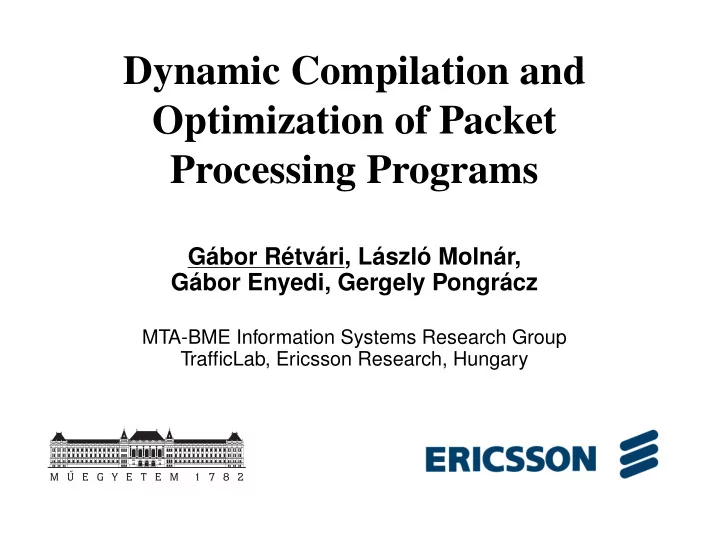

Dynamic Compilation and Optimization of Packet Processing Programs Gábor Rétvári, László Molnár, Gábor Enyedi, Gergely Pongrácz MTA-BME Information Systems Research Group TrafficLab, Ericsson Research, Hungary
Preface: Dynamic Optimization • Static compilation: offline transformation of source code into an executable • Dynamic compilation: online program optimization using information only available at run time
Preface: Dynamic Optimization Can we use the same techniques for data-plane compilation?
Agenda • What we mean by “dynamic data-plane compilation” • ES WITCH 4P4: a dynamically optimizing P4 compiler • Case studies
Static Data-plane Compilation • P4 program describes data-plane semantics • Data-plane behavior can be configured online
Dynamic Data-plane Compilation • A dynamic compiler has access to the semantics as well as the behavior and optimizes for both
Example for OpenFlow: ES WITCH L. Molnár, G. Pongrácz, G. Enyedi, Z. L. Kis, L. Csikor, F. Juhász, A. Kőrösi, and G. Rétvári. Dataplane specialization for high performance OpenFlow software switching. In ACM SIGCOMM, 2016.
ES WITCH 4P4 • A proof-of-concept dynamic P4 compiler and software switch we have started to experiment with • Template-based code generation for fast data-plane synthesis (runs on every table_add / table_delete !) • Currently uses a small (64-bit) per-packet scratchpad and supports only 3 general templates ◦ read : read field from header to scratchpad (parse) ◦ match : match scratchpad content at given offset against some key (match) ◦ write : write scratchpad to header field (deparse) • Demonstrate some dynamic compilation techniques on hand-crafted P4 use cases
Dead Code Elimination • At any point in time many packet processing features may go unused, like many switches ◦ may run with empty ACLs ◦ may not terminate VXLAN/GRE/MPLS tunnels ◦ may not use all possible rewrite rules • The corresponding, statically compiled code is “dead” • Configuration-dependent, revealed only at run-time • ES WITCH 4P4 compiles only the templates that are actually used: automatic dead code elimination
Dead Code Elimination: Tables table acl { key = { ... } Unnecessary when no ACL actions = { ... } size = ... ; default_action = drop ; } ... apply { ... acl.apply() ... }
Dead Code Elimination: Tables Processing time [ticks] 150 Cost of 100 potentially dead code 50 Empty pipeline 0 5 10 15 Number of consecutive (empty) match-action tables. Hand-crafted pipeline as a sequence of JITted empty tables, 10 million packets measured on Intel Core5@2.40GHz CPU/4GB DRAM/Debian/GNU Linux with pmu-tools/jevents .
Dead Code Elimination: Parser parser main_parser(packet_in b, out pkt_t p) { state start { b.extract(p.ethernet) ; transition select( p.ethernet.etherType ) { ... 0x800 : parse_ipv4 ; ... } } state parse_ipv4 { b.extract(p.ip) ; ... transition select( p.ip.protocol ) { ... 0x06 : parse_tcp ; 0x11 : parse_udp ; ... } } state parse_tcp { b.extract(p.tcp) ; ... Unnecessary when } ACL table empty state parse_udp { b.extract(p.udp) ; ... } }
Dead Code Elimination: Parser VLAN L3 UDP Parse time [CPU ticks] 150 L2 VXLAN Full 100 L3 stack VLAN w/o VXLAN L2 50 Empty pipeline VXLAN/ACL(L4) header parsing overhead Hand-crafted header parser with JITted read / match templates, 10 million identical packets measured on Intel Core5@2.40GHz CPU/4GB DRAM/Debian/GNU Linux with pmu-tools/jevents .
Just-in-time Compilation table acl { key = { ACLs may not match h.ip.srcAddr : ternary ; h.ip.dstAddr : ternary ; on all fields and match h.ip.protocol : ternary ; h.transport.srcPort : ternary ; type may not be ternary h.transport.srcPort : ternary ; } actions = { ... } Size should not need to size = 50000 ; be statically provisioned default_action = drop ; } • ES WITCH 4P4 performs on-the-fly match-action table optimization ◦ optimize packet classifier depending on content ◦ remove parsing for unused header fields ◦ do not depend on user-defined max size • Just-in-time-compile “hot” tables to machine code
Just-in-time Compilation tuple-space search 300 just-in-time compiled CPU time [ticks] 200 100 Empty pipeline 0 0 10 20 30 Number of (random) IP 5-tuple rules Hand-crafted pipeline with random match templates, 10 million identical packets measured on Intel Core5@2.40GHz CPU/4GB DRAM/Debian/GNU Linux with pmu-tools/jevents .
Constant Inlining table ipv4_lpm { reads { ipv4.dstAddr : lpm ; } actions { set_nhop ; drop; } } action set_nhop(nhop_ipv4 , port) { ... } table_add ipv4_lpm set_nhop 10 .0.0.1 /32 => 10.0.0.1 1 Subject table_add ipv4_lpm set_nhop 10 .0.0.2 /32 => 10.0.0.2 2 to inlining table_add ipv4_lpm set_nhop 10 .0.0.3 /32 => 10.0.0.3 3 ... no inline inline 70 CPU time [ticks] 60 50 Empty pipeline 0 2 4 6 8 Number of rewrite actions Hand-crafted pipeline with 15 JITted rewrite actions and write templates, 10 million identical packets measured on Intel Core5@2.40GHz CPU/4GB DRAM/Debian/GNU Linux with pmu-tools/jevents .
Conclusions • Complete switch configuration becomes available only at runtime: why compiling datapaths statically? • Well-known runtime optimization techniques can be used to improve switch performance substantially • Comes at a price: additional complexity and latency on updates • Of course there remain questions... • Is dynamic compilation worth it, after all? For SW targets definitely, but for HW??? • Which precisely are the right templates for P4?
Recommend
More recommend